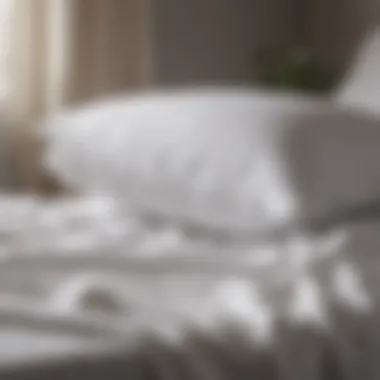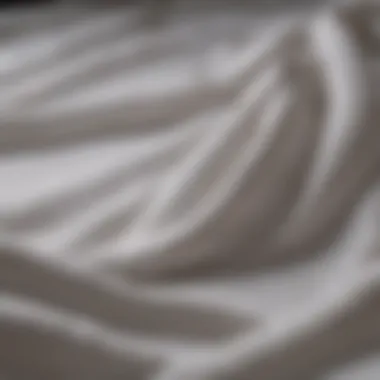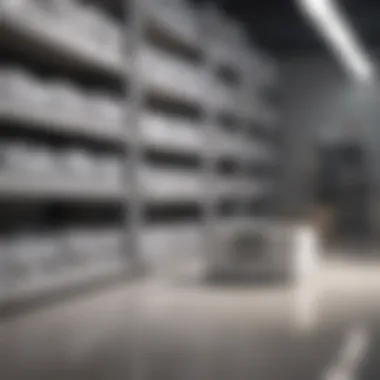Revive Your Dingy Whites: Expert Tips for Brightness


Intro
Whites are a staple in many households, serving as the backdrop for style, comfort, and cleanliness. Yet, maintaining the brightness of white fabrics can be challenging. Over time, constant use and exposure to various elements can cause whites to become dingy and yellowed. This discoloration can arise from several factors, such as detergent residues, body oils, and environmental pollutants. Understanding this degradation helps in selecting effective methods for restoration.
In this guide, homeowners, design enthusiasts, and anyone who values a pristine aesthetic will benefit from practical insights and techniques. Restoring white fabrics does not require exorbitant products or complicated processes. Instead, a mix of conventional wisdom and innovative methods provides a pathway to achieve defined cleanliness.
Dive into the sections below to explore effective cleaning techniques, product recommendations, and preventive care to keep white linens and garments looking fresh and vibrant.
Understanding the Causes of Dingy Whites
Dingy whites are a common issue for many homeowners. Appreciating the causes is a vital phase in restoring white fabrics. Understanding how various factors lead to discoloration helps formulate effective cleaning strategies. This knowledge contributes significantly to maintaining the brightness of whites over time. It reveals essential practices that can circumvent problems before they occur.
Chemical Reactions in Fabrics
Fabrics undergo chemical reactions over time that may lead to yellowing or graying. These reactions can be triggered by various factors, including sweat, body oils, and skin products. When these substances mix with the fibers, they can create complex compounds that contribute to the dingy appearance of whites. In addition, exposure to heat can exacerbate these reactions. For instance, washing whites in hot water might seem beneficial. However, it can sometimes set stains instead of removing them.
Environmental Factors Leading to Discoloration
Environmental factors play a significant role in the degradation of white clothing. Airborne pollutants, like dust and smoke, settle on fabrics, dulling their brightness. Furthermore, sunlight, while essential for drying clothes, can also fade fabric colors. If whites are not protected, their fibers can break down under prolonged exposure, leading to noticeable yellowing. Humidity can create an environment promoting mildew growth, which also affects whites. Thus, understanding the surrounding environment is crucial for preserving the integrity of white fabrics.
The Role of Detergents and Additives
Not all detergents are created equal. Some may be harsh on fabrics, leading to degradation over time. Ingredients in certain laundry detergents may react with fabric fibers, causing discoloration. Additionally, additives like bleach can worsen the issue. While bleach is meant to whiten, its improper use can result in weakening fibers and ultimately lead to a dingier appearance. Therefore, selecting the right detergent and understanding its components is vital for maintaining the brightness of whites.
Assessment Before Cleaning
Assessing the condition of your white fabrics is a crucial step before diving into cleaning methods. Understanding what you are dealing with not only informs the appropriate cleaning strategy to use but also helps avoid potential damages. Different fabrics react differently to cleaning agents and methods. If one does not properly identify the fabric type or evaluate the extent of discoloration, the application of an incorrect approach could lead to more harm than good. Thus, having a clear assessment can substantially increase the chances of achieving optimal results in restoring the brightness of white items.
Thorough evaluation also saves time and resources. For example, if a fabric requires only a gentle cleaning method, using a strong bleaching agent might not just be unnecessary; it could lead to weakened fibers or even an unattractive yellowing effect. Therefore, careful assessment is indispensable for anyone wanting to restore dingy whites.
Identifying Fabric Types
Identifying the type of fabric is foundational to the cleaning process. Fabrics such as cotton, polyesters, and blends vary significantly in their composition, which dictates how they respond to various cleaning agents. Here are some common fabric types:
- Cotton: Naturally resilient and washable, it usually handles strong agents well but can weaken over time with excessive use of bleach.
- Linen: While this fabric can tolerate a good wash, it may wrinkle easily and can be sensitive to overexposure to sunlight.
- Polyester: Synthetic and often more stain resistant. It usually requires lower washing temperatures but can accumulate more dirt if not maintained properly.
- Silk: This delicate fabric needs special care. It can easily suffer from discoloration, and strong chemicals should be avoided at all costs.
To identify the fabric type, check the care label often sewn into the seams. This label not only provides the material composition but also care instructions crucial for safe and effective cleaning.
Evaluating the Degree of Discoloration
Once fabric types are identified, the next step is evaluating the degree of discoloration. This requires a discerning eye to pinpoint the level of yellowing or dinginess. Here are some factors to consider:
- Extent of Yellowing: Is it a light cast or severe discoloration? Light yellowing may respond well to home remedies, while heavily discolored items might need commercial products.
- Stains vs. Overall Dinginess: Are there specific stains present, or is the fabric generally losing its brightness? Targeting stains can require specific methods differing from those used for overall whitening.
- Affected Areas: Identify whether the discoloration is uniform or concentrated in specific areas, which could indicate a reaction to sweat, body oils, or environmental impacts.


By understanding the severity and nature of discoloration, one can select the right cleaning technique or product, thereby optimizing the chances of successfully restoring the whites to their original condition.
"Knowledge is the first step towards effective restoration. Understanding your fabrics and their condition ensures that your cleaning efforts have the best chance of success."
In summary, thorough assessment is essential before proceeding with any cleaning endeavor. Proper identification of fabric types and careful evaluation of discoloration levels lay the groundwork for more effective restoration techniques.
Simple Home Remedies for Whites Restoration
Restoring dingy whites doesn't always require harsh chemicals or expensive products. Simple home remedies can be effective, safe, and cost-efficient alternatives for homeowners and other individuals seeking to improve the brightness of their white fabrics. These methods not only contribute to the aesthetic appeal of white linens and garments but also reduce waste and promote sustainability by utilizing everyday household items. Additionally, many of these remedies are accessible, requiring minimal preparation and effort, making them suitable for busy lifestyles.
Incorporating these simple remedies can yield impressive results. They often use common items like baking soda, vinegar, and lemon juice. Each item plays a specific and vital role, often without any negative impact on the fabric. Understanding how these ingredients work reinforces the value of integrating them into your laundry routine.
Baking Soda and Vinegar Method
The baking soda and vinegar method stands as one of the most popular home remedies for reviving white fabrics. Both ingredients are known for their cleaning and whitening properties. Baking soda, a mild abrasive, helps to lift stains and neutralize odors, while vinegar effectively breaks down residue and acts as a natural fabric softener.
To utilize this method:
- Start by filling your washing machine with hot water.
- Add 1 cup of baking soda and 1 cup of white vinegar once the machine is full.
- Place the dingy whites in the machine and let them soak for about 30 to 60 minutes.
- After soaking, proceed to wash them on your usual cycle.
This combination not only whitens but also refreshes the fabric by eliminating lingering smells. It is essential to ensure all items are color-safe before using hot water, as some fabrics may react negatively.
Lemon Juice and Sunlight Technique
Another effective remedy employs lemon juice and sunlight. Both elements together cater to the restoration of brightness in white fabrics without the use of harsh chemicals. Lemon juice contains citric acid, which acts as a natural bleaching agent. Sunlight enhances this effect by providing natural ultraviolet rays that help to whiten fabric.
To effectively implement this technique:
- Mix 1 cup of lemon juice with a gallon of water in a soaking basin.
- Submerge your whites in the lemon-water solution and allow them to soak for several hours or overnight.
- After soaking, thoroughly rinse and wring out the excess water.
- Finally, hang the clothes in direct sunlight to dry.
This method is particularly suitable for whites that can withstand sunshine, as the heat accelerates the whitening process. It is worth noting that caution should be applied when exposing certain fabrics to prolonged sunlight, as fading could occur.
Utilizing these simple home remedies not only revives dingy whites but also promotes eco-friendly practices in everyday routines.
Commercial Products for Whitening
Commercial products for whitening play a vital role in restoring the brightness of dingy white fabrics. While home remedies can offer effectiveness, many homeowners find that specialized commercial agents produce quicker and more noticeable results. It is essential to understand how these products work and their potential benefits to make informed choices.
Overview of Whitening Agents
Whitening agents come in various forms, such as powders, gels, and liquid formulas. Each type has its own advantages. Common whitening agents include hydrogen peroxide, sodium percarbonate, and optical brighteners. Hydrogen peroxide is often used as a safe and eco-friendly option. It works effectively to remove stains and brightens textiles without harsh chemicals. Sodium percarbonate acts as a stain remover that activates when mixed with water, releasing oxygen to lift dirt and stains away. Optical brighteners, on the other hand, are synthetic compounds that absorb ultraviolet light and reflect it, giving white fabrics a bright appearance under sunlight.
Here's a brief overview of the most common whitening agents:
- Hydrogen Peroxide: Non-toxic, helps eliminate tough stains.
- Sodium Percarbonate: Eco-friendly, activates in water for dirt removal.
- Optical Brighteners: Enhances brightness by reflecting UV light.


Selecting between these agents depends on the level of discoloration and any fabric-specific concerns. Always read the labels to ensure compatibility with your garments.
Choosing the Right Product
Choosing the right commercial product for whitening may seem challenging given the multitude of options available. However, a systematic approach can simplify this process.
- Assess the Fabric Type: Different fabrics may react differently to specific chemicals. Always check if the product is suitable for your fabric.
- Check for Safety Certifications: Look for products that are labeled free from harmful substances and allergens. This is especially crucial for sensitive skin.
- Performance Reviews: Researching user reviews and ratings helps gauge the effectiveness of whitening products. Websites like reddit.com or specialized cleaning forums can provide insights based on real-user experiences.
- Cost vs. Effectiveness: Higher-priced products do not always guarantee better results. Compare various brands focusing on customer feedback and product performance.
In summary, investing time in choosing the right commercial whitening product can significantly enhance the brightness of your dingy whites. Keep in mind that a combination of suitable agents and correct application techniques leads to the best outcomes.
Washing Techniques for Optimal Results
Washing techniques play a crucial role in restoring dingy white fabrics to their former brightness. Proper washing methods do not only help in removing stains and yellowing but also prevent further discoloration. Understanding how to wash whites effectively is important for homeowners who wish to maintain crisp and clean linens and garments.
When it comes to white fabrics, both the process and the products used need consideration. A successful wash requires more than just tossing clothes into the machine. Factors like water temperature, detergent choice, and washing cycle can dramatically affect the outcome.
Adjusting Water Temperature
The water temperature is a significant element in the washing process. Hot water can be very effective in breaking down dirt and stains. However, it is not always suitable for every fabric type.
Many white fabrics can benefit from a hot wash, as this heat can help to remove ingrained dirt and stubborn stains. Conversely, some fabrics, like delicate linens, may shrink or become damaged in high heat.
According to fabric care labels, it is advisable to wash whites in hot water unless specified otherwise. Temperatures around 130°F (54°C) can be effective for tougher stains.
- Benefits of hot water:
- Breaks down stains effectively.
- Kills bacteria and allergens.
Remember also that too high temperatures can lead to fading over time or fabric wear, especially with synthetics. Always check the garment label before deciding.
Proper Loading of the Washing Machine
How you load your washing machine can significantly affect the cleaning efficiency. Proper loading allows for adequate movement and circulation of water and detergent, ensuring an even wash.
- Avoid Overloading:
Overloading the machine can prevent clothes from getting the wash they need. It restricts the movement and can lead to unresolved stains. - Separate Fabrics:
It's advisable to keep whites separate from colors and other fabrics. Mixing can cause color bleed, leading to dingy whites. - Arrange Strategically:
Place larger items, like sheets, at the bottom and smaller items on top to enhance washing effectiveness.
Proper loading is not just about aesthetics; it is about achieving the best possible results with the resources you have.
Taking these considerations into account can greatly improve the success of your washing, ensuring that whites remain bright and clean. In the subsequent sections, further methods will be discussed to fully maximize the restoration of your dingy white fabrics.
Drying Strategies to Avoid Dinginess
Proper drying techniques play a critical role in maintaining the vibrant look of white fabrics. After washing, if drying is not executed thoughtfully, whites can easily lose their brightness and regain the dingy appearance that they previously had.


Selecting between air drying and machine drying is essential. Each method has its unique benefits and considerations.
Air Drying vs. Machine Drying
Air drying is often seen as the gentler approach. It involves hanging the fabrics outdoors or inside, which allows them to dry slowly. This method helps reduce wear and tear caused by the harsh motions of a washing machine drier. Furthermore, air drying can enhance the fabric's color retention. However, it does require time, which may not suit all schedules.
On the other hand, machine drying can be a convenient option, providing a quicker solution. Yet, it can sometimes cause whites to gray over time. The high temperatures in the dryer can set stains and discoloration, leading to dinginess. Thus, if one chooses to machine dry, it is crucial to use lower heat settings to protect fabric integrity.
"Choosing the right drying method can significantly impact the longevity and appearance of your white fabrics."
Managing Exposure to Sunlight
Sunlight can have a dual role in the drying process. While it can effectively brighten whites naturally, excessive exposure can lead to yellowing over time. The ultraviolet rays from the sun can degrade fabric fibers. Therefore, if drying outdoors, it is wise to monitor the time spent under direct sunlight.
To optimize the drying process while minimizing potential harm, consider these tips:
- Rotate fabrics frequently to ensure even exposure.
- Try partial shade rather than full sun for extended drying times.
- Use a clothesline with a cover, if possible, to shield from the harshest rays.
Preventive Measures for Maintaining White Fabrics
Maintaining the brightness of white fabrics is often a challenge, but it can be accomplished through effective preventive measures. Regular attention to your whites can prolong their freshness and prevent dinginess over time. Simple habits can make a notable difference. Awareness and proactive care are key to ensuring your whites remain vibrant.
Regular Maintenance Tips
Routine care contributes significantly to the longevity of white fabrics. Here are some practical tips to implement:
- Wash Whites Separately: Always wash white fabrics apart from colored items. This prevents color transfer and keeps whites looking crisp.
- Use Appropriate Detergents: Opt for detergents designed specifically for whites. These often contain optical brighteners, which help maintain brightness and counteract yellowing.
- Avoid Overloading the Washing Machine: Overloading can lead to ineffective cleaning. Ensure there is enough space for water and detergent to circulate freely around fabrics.
- Pre-treat Stains Promptly: Address stains immediately with an appropriate stain remover before laundering to prevent them from setting.
- Choose Proper Cycle Settings: Use a longer wash cycle for heavily soiled items. A short cycle may not provide adequate cleaning.
Incorporating these habits into your laundry routine can lead to visibly brighter whites.
Storing Whites Properly
How you store your white fabrics is crucial to their succcesful maintenance. Poor storage practices can lead to yellowing and wear. Consider the following tips:
- Choose a Cool, Dry Place: Store whites in an area that avoids humidity and moisture, as damp conditions can promote mildew and yellowing.
- Use Breathable Fabrics: When packing away whites, avoid plastic bags. Instead, use cotton or linen storage bags to allow airflow and prevent moisture buildup.
- Avoid Direct Sunlight: While drying is best done in sunlight, make sure to store whites away from direct exposure. Prolonged sunlight can cause the fibers to break down over time.
- Fold Instead of Hang: When storing, folding whites instead of hanging can prevent stretching and loss of shape, preserving their integrity.
By following these simple guidelines, one can significantly enhance the appearance and lifespan of white fabrics, ensuring they remain bright and fresh for a longer period.
Finale
In this article, we have explored various techniques and methods to rejuvenate dingy white fabrics. The importance of keeping whites bright cannot be understated, particularly for homeowners and those engaged in interior design. Fresh, clean whites enhance the overall aesthetic of a space, creating an atmosphere of tidiness and elegance. Moreover, maintaining white fabrics can extend their lifespan, proving both economical and practical.
Summary of Key Practices
To effectively restore and care for your white fabrics, consider the following key practices:
- Assess Fabric Types: Understanding the nature of your fabrics is essential for choosing appropriate cleaning methods.
- Utilize Home Remedies: Employing simple solutions like baking soda or lemon juice can be an effective and eco-friendly way to whiten fabrics.
- Select Commercial Products Wisely: Choosing the right whitening agents can yield significant results. Pay attention to ingredients and instructions for best outcomes.
- Appropriate Washing Techniques: Utilize correct water temperature and load capacities to optimize washing.
- Correct Drying Strategies: Be mindful of drying methods to avoid further dinginess in your whites.
Regular maintenance can significantly prevent discoloration, preserving the integrity of your textiles.
Encouragement for Continued Care
Restoring brightness to dingy whites is a journey, not a destination. By committing to a consistent regimen of cleaning and maintenance, you ensure that your white fabrics remain in fine condition. Incorporate regular checks for stains and discoloration into your routine, enabling you to address issues before they become more pronounced. Proper storage, along with periodic washing, will help maintain the vibrancy of your whites.
As you continue to care for your white garments and linens, remember that the effort you invest today will pay dividends in the future. A clean, bright collection of whites will enhance the look of your home, reflecting a commitment to detail and care.







